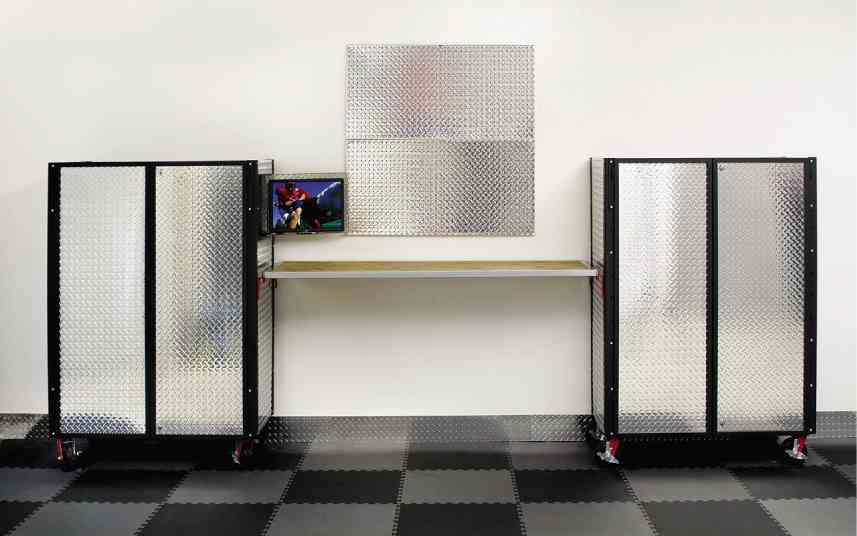
WATERTIGHT emergency cabinets such as these, in an outdoor, easy-to-access area make for sturdy storage to keep all your emergency equipment and supplies: everything from shelf-stable food and canned goods, to sanitation supplies; work equipment like work gloves, picks, axe and shovels; medicines and first aid kit; candles, matches and extra batteries photo by garageenvy.com
As I write, Supertyphoon “Yolanda” is barreling into Philippine waters. She’s an extremely dangerous Category 5 supertyphoon, the fourth one this year in the Western Pacific. Earth has averaged 4.4 of these mightiest of the mighty tropical cyclones per year. She came a little too soon after the Visayas has just been shaken and stirred by a powerful earthquake. This year so far, there have been a total of 154 earthquakes in the country. And in Manila, we’re all waiting and preparing for the “Big One.”
The Philippines ranks as the third most disaster-prone country in the world—thanks to the high exposure to the Pacific waters, exposing us to coastal hazards like ocean-driven typhoons and even tsunamis. And, needless to say, we sit right along the Pacific Rim of Fire, the basin with a contiguous belt of volcanoes, oceanic trenches and faults. The Ring of Fire has 452 volcanoes and it is where 90 percent of the world’s earthquakes occur.
Preparedness will keep us within the bounds of safety in both our own homes and workplaces despite these enormous threats. There are small measures we can undertake in order to welcome these unwanted, yet inevitable occurrences. Here are a few tips to lessen our vulnerability to danger and damage:
1. During construction work, pay specific attention to joints and fixings of the various structural elements: columns, beams and rafters. During a typhoon or earthquake, these would be the spots that suffer the most strain. Play safe, and ask your structural engineers for additional reinforcements. During construction, have your team of engineers check that the installations were properly executed by the contractor.
2. Check your roofs for clogged gutters. If you have large trees surrounding your home, it is advisable to cover your gutters with mesh-like wire to keep leaves from falling into them. Overflowing gutters will cause water to seep into your roof cavity and into your ceilings or walls. Gypsum ceilings will collapse when soaked wet.
3. Inspect your roofs for loose shingles, tiles or metal sheets. One loose tile is all it takes for your roof to start peeling away with strong wind. And believe me, roof tiles can fly away.
4. Run duct tape across large windows during strong wind. You will notice that glass can slightly “bubble” and potentially burst. Duct tape helps keep the glass from rupturing, or worse, keeps it from shattering and falling. This especially applies to those living in tall buildings or exposed areas with high wind velocities. This is something I used to do quite often in Hong Kong where I lived many years ago, especially after seeing that the wind was strong enough to shift the position of our window-type air conditioners from their ledges.
5. Fix tall pieces of furniture like bookshelves or armoires to the wall, even when they appear to be stable, standing on their own. Either bolt them from the inside or use eye bolt on both wall and furniture piece, then attach together with wire. A strong earthquake can displace the center of balance of these pieces.
6. Keep heavier objects at the bottom of your tall furniture. It will help weigh down the furniture pieces.
7. Use proper hooks for your artwork and mirrors. Plastic hooks that are simply hammered onto a concrete wall may work for small pieces, but large artwork and frames need hooks that are properly and screwed deeply into walls. For heavier pieces, use two hooks installed a few inches apart.
8. Invest in a small generator or a large battery pack (a UPS), even one that’s just enough for emergency lighting, charging digital and electric equipment.
9. Make sure that your piped-in gas lines have safety valves that can be automatically or manually shut. An earthquake can shear your pipes and cause a gas leak.
10. Have a small water tank to store tap water. This is easier to maintain than many small bottles of water. Incorporate it in your water inlet so that the water is always being used and replenished, keeping it fresh for consumption in case your water main lines are cut. The rule is to have a gallon per person per day. Allow for three days’ storage. Don’t forget your household staff.
11. Have a watertight emergency cabinet in an outdoor, easy-to-access area. Construct this out of cement fiberboard or steel and to keep there all your emergency equipment and supplies there—everything from shelf-stable food and canned goods, to sanitation supplies; work equipment like work gloves, picks, axe and shovels; medicines and first aid kit; candles, matches and extra batteries.
12. Batten down the hatches, literally. Stay indoors and keep doors and windows shut during a typhoon, but stay outside during an earthquake and don’t attempt to go in if there are signs of structural damage or collapse. With strong wind, structures take pressure from the outside better than from within. Wind pressure coming into a house makes its way up into voids and can push down ceiling and overhangs. Strong winds can also suck down your terrace or balcony ceiling.
In the age of powerful calamities in a disaster-prone region, be prepared and say a prayer. God helps those who help themselves.
Contact the author through designdimensions@abi.ph or through our Asuncion Berenguer Facebook account.

